Strength training, an essential component of any fitness regimen, offers a multitude of benefits for overall well-being. Whether you’re a seasoned athlete or just starting your fitness journey, incorporating the best exercises for strength into your routine can help you build muscle, improve bone density, boost metabolism, and enhance cognitive function.
This comprehensive guide will delve into the fundamentals of strength training, providing you with the knowledge and tools you need to maximize your results. We’ll cover compound and isolation exercises, progression and variation, proper form and technique, frequency and intensity, recovery and nutrition, warm-up and cool-down, safety precautions, and special considerations for different populations.
By the end of this guide, you’ll have the confidence and expertise to embark on a strength training program tailored to your individual needs and goals.
Introduction
Strength training is an essential component of overall fitness and well-being. It helps build and maintain muscle mass, which is important for everything from everyday activities to athletic performance. Strength training can also help improve bone density, reduce the risk of injury, and boost metabolism.
The “best exercises for strength” are those that work multiple muscle groups and allow you to lift heavy weights. These exercises include:
- Squats
- Deadlifts
- Bench press
- Overhead press
- Barbell rows
Compound Exercises
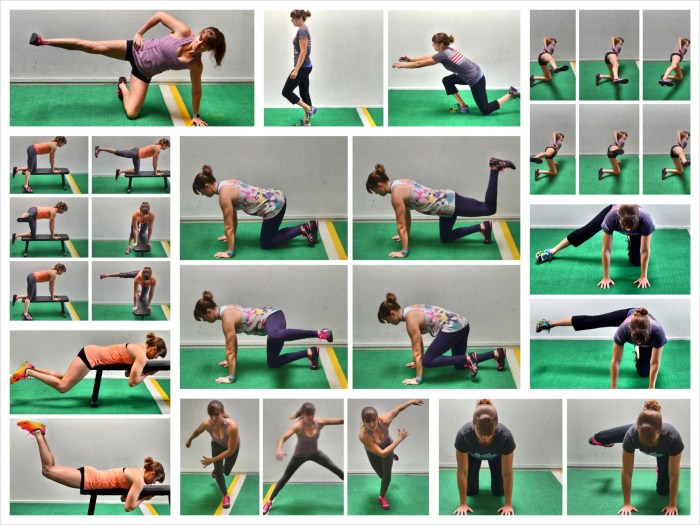
Compound exercises are those that work multiple muscle groups simultaneously. They are highly effective for building strength because they allow you to lift heavier weights and stimulate more muscle fibers.
Some of the best compound exercises for strength include:
Squats
Squats are a full-body exercise that works the legs, glutes, and core. They are a great way to build overall strength and power.
Deadlifts
Deadlifts are a full-body exercise that works the legs, back, and core. They are one of the most challenging exercises you can do, but they are also one of the most effective for building strength.
Bench Press
The bench press is a chest exercise that also works the shoulders and triceps. It is a great way to build upper body strength and power.
Overhead Press
The overhead press is a shoulder exercise that also works the triceps and core. It is a great way to build upper body strength and stability.
Barbell Rows
Barbell rows are a back exercise that also works the biceps and forearms. They are a great way to build back strength and thickness.
Isolation Exercises
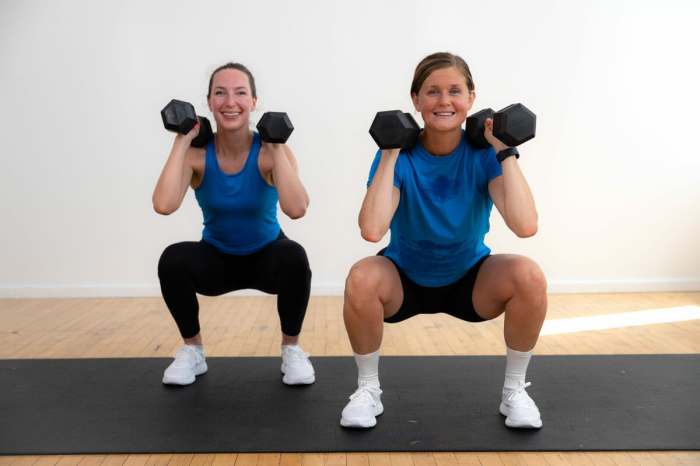
Isolation exercises are a type of strength training that focuses on working one muscle group at a time. This is in contrast to compound exercises, which work multiple muscle groups at once. Isolation exercises can be beneficial for increasing muscle isolation, improving muscle definition, and reducing the risk of injury.
Bicep Curls
Starting position
Stand with your feet shoulder-width apart, holding a dumbbell in each hand. Your palms should be facing forward and your elbows should be bent at 90 degrees.
Movement pattern
Curl the dumbbells up towards your shoulders, keeping your elbows close to your body.
Range of motion
Curl the dumbbells up until your forearms are parallel to the floor.
Common mistakes
Using too much weight, swinging your arms, and not keeping your elbows close to your body.
Tricep Extensions
Starting position
Sit on a bench with your feet flat on the floor. Hold a dumbbell in each hand, with your palms facing forward.
Movement pattern
Extend your arms overhead, keeping your elbows close to your head.
Range of motion
Extend your arms until they are fully extended.
Common mistakes
Using too much weight, flaring your elbows out, and not keeping your elbows close to your head.
Leg Extensions
Starting position
Sit on a leg extension machine with your feet flat on the platform.
Movement pattern
Extend your legs until they are fully extended.
Range of motion
Extend your legs until they are fully extended.
Common mistakes
Using too much weight, bouncing your legs, and not keeping your back straight.
Hamstring Curls
Starting position
Lie face down on a hamstring curl machine with your feet flat on the platform.
Movement pattern
Curl your legs up towards your glutes, keeping your knees bent at 90 degrees.
Range of motion
Curl your legs up until your hamstrings are fully contracted.
Common mistakes
Using too much weight, swinging your legs, and not keeping your back straight.
Calf Raises
Starting position
Stand with your feet flat on the floor, shoulder-width apart.
Movement pattern
Raise up onto your toes, keeping your knees straight.
Range of motion
Raise up onto your toes until your calves are fully contracted.
Common mistakes
Using too much weight, bouncing your legs, and not keeping your back straight.
Progression and Variation
Consistency is key in strength training, but it’s also essential to challenge your muscles gradually to keep seeing results. Progression and variation are the cornerstones of any effective strength training program.
Progression means gradually increasing the weight, sets, reps, or exercises over time. This forces your muscles to adapt and grow stronger. Variation, on the other hand, involves changing up your exercises, sets, and reps to target different muscle groups and movement patterns.
Tips for Progression
- Start with a weight that’s challenging but allows you to maintain good form.
- Gradually increase the weight by 5-10% every 2-3 weeks.
- Add an extra set or two to your workouts every 2-3 weeks.
- Increase the number of reps you do in each set by 1-2 every 2-3 weeks.
- Incorporate new exercises into your routine every 4-6 weeks.
Tips for Variation
- Choose exercises that target different muscle groups.
- Vary the order of your exercises to work different muscles first.
- Change the tempo of your exercises (e.g., slow down the eccentric phase).
- Use different equipment (e.g., dumbbells, barbells, kettlebells).
- Incorporate bodyweight exercises into your routine.
Form and Technique
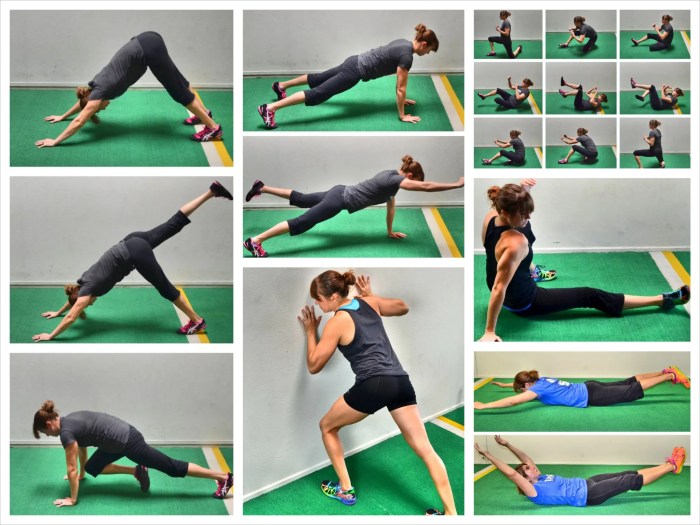
Perfecting your form and technique is crucial for optimizing results while minimizing injury risks. Focus on mastering the correct starting position, movement pattern, and ending position for each exercise. Execute each movement with precision and control, paying attention to body alignment and muscle engagement.
Starting Position
- Ensure proper posture and body alignment, creating a solid foundation for the exercise.
- Stand with feet hip-width apart, knees slightly bent, and back straight.
- Grip the barbell with hands slightly wider than shoulder-width, palms facing forward.
Movement Pattern
- Inhale and slowly lower the barbell towards your chest, keeping your elbows tucked in.
- Lower the barbell until it touches your chest, then exhale and press the barbell back up to the starting position.
- Maintain a neutral spine and engage your core throughout the movement.
Ending Position
- Return to the starting position with the barbell fully extended overhead.
- Keep your head up and chest out, maintaining proper posture.
- Control the descent and avoid locking out your elbows at the top of the movement.
Frequency and Intensity
Optimizing frequency and intensity is crucial for maximizing strength gains. The ideal approach varies based on individual goals, fitness levels, and recovery capacity.
Generally, for beginners, a frequency of 2-3 full-body workouts per week is recommended. As you progress, you can increase the frequency to 3-4 days per week, focusing on specific muscle groups on different days.
Sets, Reps, and Rest
The number of sets, reps, and rest periods you choose will depend on your training goals and fitness level. For strength building, aim for 3-5 sets of 8-12 repetitions with a rest period of 2-3 minutes between sets.
Progressive Overload
Progressive overload is essential for continuous strength improvement. Gradually increase the weight, resistance, or reps over time to challenge your muscles and stimulate growth. This can be done by adding weight, increasing the number of reps, reducing rest periods, or using advanced training techniques.
Rest and Recovery
Rest and recovery are vital components of strength training. Allow your body sufficient time to repair and rebuild after workouts. Aim for 7-9 hours of sleep per night and schedule rest days as needed.
Sample Workout Plans
Beginner Plan (2 days per week)
- Monday: Full-body workout (squats, push-ups, rows, lunges)
- Thursday: Full-body workout (deadlifts, bench press, shoulder press, bicep curls)
Intermediate Plan (3 days per week)
- Monday: Leg day (squats, leg press, calf raises)
- Wednesday: Upper body push (bench press, shoulder press, tricep extensions)
- Friday: Upper body pull (deadlifts, rows, bicep curls)
Safety Precautions

Strength training exercises involve lifting weights and applying force to your body. To ensure a safe and effective workout, it’s crucial to follow certain safety precautions.
Remember, the primary goal is to improve strength and fitness, not to push yourself beyond your limits or risk injury. Here are some key safety tips to keep in mind:
Lifting Weights Safely
- Always warm up before lifting weights to prepare your body for the exercise.
- Choose an appropriate weight that challenges you but doesn’t compromise your form.
- Use proper lifting technique to minimize the risk of injury.
- Don’t lift weights that are too heavy for you.
- Use a spotter when lifting heavy weights.
Avoiding Injuries
- Listen to your body and stop if you experience any pain.
- Stretch regularly to improve flexibility and reduce the risk of muscle strains.
- Use proper footwear to provide support and stability.
- Avoid overtraining, which can lead to injuries.
Knowing When to Stop
- Pay attention to your body’s signals and stop if you feel dizzy, nauseous, or short of breath.
- Don’t push yourself too hard, especially if you’re new to strength training.
- If you have any underlying health conditions, consult with a healthcare professional before starting a strength training program.
10. Special Considerations
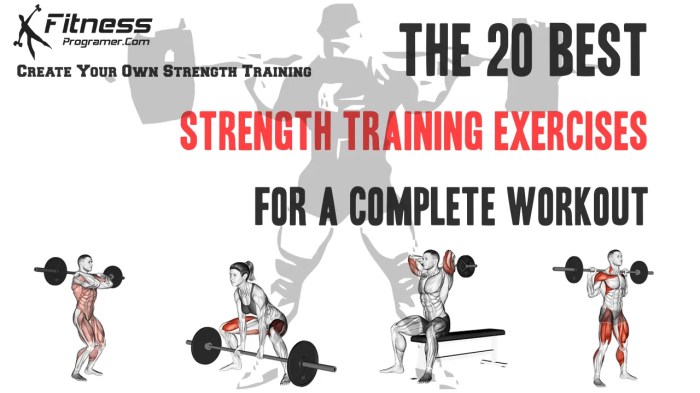
Specific populations may require modifications to the exercises to ensure safety and effectiveness.
The following table summarizes the considerations for different populations:
| Population | Considerations |
|---|---|
| Beginners | Start with a light weight and gradually increase it as you get stronger.Focus on proper form to avoid injury.Choose exercises that target multiple muscle groups to maximize efficiency. |
| Advanced lifters | Use a challenging weight that allows you to perform 8-12 repetitions with good form.Incorporate advanced techniques like drop sets and supersets to increase intensity.Pay attention to rest and recovery to avoid overtraining. |
| Individuals with injuries or health conditions | Consult with a doctor or physical therapist before starting any exercise program.Choose exercises that do not aggravate the injury or condition.Modify the exercises as necessary to ensure safety and comfort. |
Remember:It’s always best to consult with a qualified fitness professional for personalized guidance and exercise modifications.
Modifying Exercises for Different Populations, Best exercises for strength
- For beginners, use lighter weights, focus on proper form, and choose compound exercises.
- For advanced lifters, increase the weight, incorporate advanced techniques, and prioritize rest.
- For individuals with injuries or health conditions, modify exercises to avoid aggravating the condition and ensure safety.
Sample Strength Training Program
Strength training is an essential component of any fitness routine, and it’s especially beneficial for beginners. Strength training can help you build muscle, burn fat, and improve your overall health. If you’re new to strength training, it’s important to start with a beginner-friendly program that will help you build a solid foundation.
Here’s a sample strength training program for beginners that you can follow to get started.
This program is designed to be done 2-3 times per week, with at least one day of rest between workouts. Each workout will consist of 8-10 exercises, with 2-3 sets of each exercise. The weight you choose should be challenging, but not so heavy that you can’t complete the prescribed number of reps with good form.
Rest for 1-2 minutes between sets, and take a 5-minute break between exercises.
Exercises
| Exercise | Sets | Reps | Rest |
|---|---|---|---|
| Barbell Squat | 3 | 10-12 | 1-2 minutes |
| Bench Press | 3 | 10-12 | 1-2 minutes |
| Dumbbell Row | 3 | 10-12 | 1-2 minutes |
| Overhead Press | 3 | 10-12 | 1-2 minutes |
| Pull-Up | 3 | 8-10 | 1-2 minutes |
| Push-Up | 3 | 10-12 | 1-2 minutes |
| Dumbbell Lunge | 3 | 10-12 | 1-2 minutes |
| Calf Raise | 3 | 15-20 | 1-2 minutes |
This program is just a starting point, and you can adjust it to fit your own needs and goals. If you’re new to strength training, it’s important to start slowly and gradually increase the weight and intensity of your workouts over time.
And, as always, be sure to consult with a qualified personal trainer if you have any questions or concerns.
Tips for Beginners
- Start with a weight that is challenging, but not too heavy.
- Focus on proper form, rather than lifting as much weight as possible.
- Rest for 1-2 minutes between sets, and take a 5-minute break between exercises.
- Listen to your body and don’t push yourself too hard.
- Be patient and consistent with your workouts.
Warm-Up and Cool-Down
It’s important to warm up before strength training and cool down afterward. A warm-up will help to prepare your body for the workout, and a cool-down will help to reduce muscle soreness and stiffness.
Warm-Up
- 5 minutes of light cardio, such as walking or jogging
- Dynamic stretches, such as arm circles and leg swings
- 5 minutes of light weights, such as 50% of your working weight
Cool-Down
- 5 minutes of light cardio, such as walking or jogging
- Static stretches, such as holding each stretch for 30 seconds
Benefits of Strength Training

Strength training is an excellent way to improve your overall health and well-being. It can help you build muscle, lose weight, and reduce your risk of chronic diseases.
Here are some of the specific benefits of strength training:
Increased Muscle Mass
Strength training helps you build muscle mass, which can help you burn more calories and improve your overall strength. Increased muscle mass can also help you improve your posture and balance.
Improved Bone Density
Strength training can help you improve your bone density, which can reduce your risk of osteoporosis. Osteoporosis is a condition that causes bones to become weak and brittle.
Enhanced Metabolism
Strength training can help you boost your metabolism, which can help you burn more calories and lose weight. A faster metabolism can also help you improve your energy levels.
Reduced Risk of Chronic Diseases
Strength training can help you reduce your risk of chronic diseases, such as heart disease, stroke, type 2 diabetes, and cancer. Strength training can help you improve your blood pressure, cholesterol levels, and blood sugar control.
Improved Mood and Cognitive Function
Strength training can help you improve your mood and cognitive function. Strength training can help release endorphins, which have mood-boosting effects. Strength training can also help improve your sleep quality, which can lead to better cognitive function.
| Age Group | Fitness Level | Benefits |
|---|---|---|
| Children | All | Improved bone density, coordination, and balance |
| Adolescents | All | Increased muscle mass, improved bone density, and reduced risk of obesity |
| Adults | Beginner | Improved muscle mass, bone density, and metabolism |
| Adults | Intermediate | Increased muscle mass, strength, and power |
| Adults | Advanced | Increased muscle mass, strength, and power |
| Seniors | All | Improved muscle mass, bone density, and reduced risk of falls |
Here are some tips for getting started with strength training:
- Start slowly and gradually increase the weight and intensity of your workouts over time.
- Choose exercises that target all major muscle groups.
- Focus on proper form to avoid injury.
- Listen to your body and rest when you need to.
- Be consistent with your workouts.
It is important to consult with a healthcare professional before beginning a strength training program, especially if you have any underlying health conditions.
Common Mistakes to Avoid: Best Exercises For Strength
To maximize the benefits of strength training and minimize the risk of injury, it’s crucial to avoid common mistakes. These include:
Using Improper Form
Maintaining proper form is essential to target the correct muscles and prevent injuries. This includes keeping a neutral spine, using a full range of motion, and controlling the movement throughout the exercise. For example, in squats, keep your back straight, descend to a parallel position, and push back up through your heels.
Lifting Too Much Weight
While it’s tempting to lift heavy weights, it’s important to start gradually and increase the weight as you get stronger. Lifting too much weight can lead to injuries and plateaus. If you reach a plateau, try deloading (reducing the weight) for a short period before gradually increasing it again.
Overtraining
Overtraining can lead to fatigue, muscle soreness, and decreased performance. Listen to your body and take rest days when needed. Symptoms of overtraining include persistent muscle soreness, difficulty sleeping, and decreased appetite.
Ignoring Rest and Recovery
Rest and recovery are crucial for muscle growth and repair. Aim for 7-9 hours of sleep per night, consume a nutritious diet, and incorporate stretching into your routine. Adequate rest allows your muscles to recover and rebuild, preparing them for the next training session.
Closing Summary
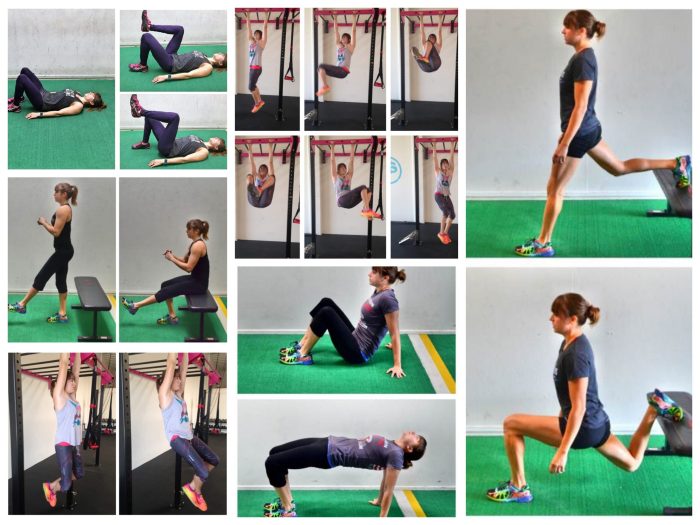
Strength training is an investment in your overall health and fitness. By incorporating the exercises and techniques Artikeld in this guide into your routine, you can reap the numerous benefits of strength training, including increased muscle mass, improved bone density, enhanced metabolism, reduced risk of chronic diseases, and improved mood and cognitive function.
Remember, consistency and proper form are key to maximizing your results. So embrace the challenge, push your limits, and unlock the transformative power of strength training.
Query Resolution
What are the benefits of strength training?
Strength training offers a wide range of benefits, including increased muscle mass, improved bone density, enhanced metabolism, reduced risk of chronic diseases, and improved mood and cognitive function.
How often should I strength train?
The optimal frequency for strength training depends on your individual fitness level and goals. Generally, it is recommended to strength train 2-3 times per week, allowing for adequate rest and recovery between workouts.
How do I choose the right weight for strength training?
When choosing a weight for strength training, it is important to start with a weight that is challenging but allows you to maintain proper form throughout the exercise. Gradually increase the weight as you get stronger.
Leave a Reply